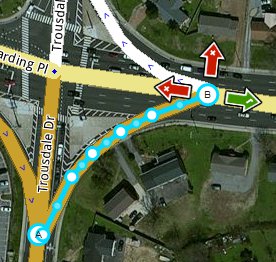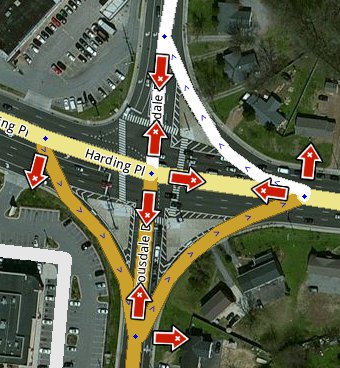mNo edit summary |
mNo edit summary |
||
| Line 44: | Line 44: | ||
The [[Junction Style Guide]] provides significant information on how to best set the geometry of the connector to get the best routing and text-to-speech result. Be sure to review that article when updating or creating these connectors. | The [[Junction Style Guide]] provides significant information on how to best set the geometry of the connector to get the best routing and text-to-speech result. Be sure to review that article when updating or creating these connectors. | ||
== {{anchor|Turn restrictions necessary for proper connector routing}} Turn restrictions == | == {{anchor|Turn restrictions necessary for proper connector routing}} Turn restrictions == | ||
[[Image: | [[Image:Left_turn_lane2.PNG|right|border|link=https://wazeopedia.waze.com/wiki/Commons/File:Left_turn_lane2.PNG]]Connectors, if simply added to the map and all turns allowed, would cause significant routing challenges, especially between two 2-way roads. Split roadways have their own challenges, but turn restrictions, due to the 1-way nature of the main segments, are simpler. | ||
In the US, a simple right-turn connector between two 2-way streets, requires that the right turn be restricted at both the primary intersection, and at the connector itself so Waze will not be allowed to tell the driver to turn left across the road to get onto the connector.{{clear}}[[Image:Atgrade example2.jpg|left|border|link=https://wazeopedia.waze.com/wiki/USA/File:Atgrade_example2.jpg]]AND, at the end of the connector, the left turn must be restricted:{{clear}}[[Image:Atgrade example4.jpg|right|border|link=https://wazeopedia.waze.com/wiki/USA/File:Atgrade_example4.jpg]]If you enable the "show all restricted connectivity arrows" function in the editor at this intersection, you can see there are many restricted turns. This is sometimes a target for someone looking to remove all restricted turns by abusing the use of the 'w' or '''Allow All''' turns function.{{clear}} | In the US, a simple right-turn connector between two 2-way streets, requires that the right turn be restricted at both the primary intersection, and at the connector itself so Waze will not be allowed to tell the driver to turn left across the road to get onto the connector.{{clear}}[[Image:Atgrade example2.jpg|left|border|link=https://wazeopedia.waze.com/wiki/USA/File:Atgrade_example2.jpg]]AND, at the end of the connector, the left turn must be restricted:{{clear}}[[Image:Atgrade example4.jpg|right|border|link=https://wazeopedia.waze.com/wiki/USA/File:Atgrade_example4.jpg]]If you enable the "show all restricted connectivity arrows" function in the editor at this intersection, you can see there are many restricted turns. This is sometimes a target for someone looking to remove all restricted turns by abusing the use of the 'w' or '''Allow All''' turns function.{{clear}} | ||
== Speed Limit == | == Speed Limit == | ||
Revision as of 22:56, 14 March 2018
Function Classification Continuity
There are instances when the Waze road typ may need to be upgraded to preserve functional classification continuity. This happens
You're doing the routing engine a favor by interpreting what the intended flow of traffic is, as in "this PS is clearly designed to be the primary route between the limited access road and the mH/MH," this meaning you can justify the upgrade the PS to match the mH/MH
Left Turn Lane(LTL)
Left turn lanes should only be mapped in very limited circumstances-
- When the turn lane physically separates from the main road well in advance of the intersection
- When there is a raised curb between the left turn lane and the through lanes for a long distance before the intersection that the driver might overshoot while waiting for a delayed "turn" audible.
- When the area is "busy" enough that the driver may not get any advance warning that a turn is coming up--in which case a left turn lane lets you notify the driver a little earlier
- When there are user complaints (Update Requests) that the audible was too late, or that the map should have shown a left turn lane
When in doubt, leave it out. Each connector complicates the map and adds to your workload when the time comes to check connectivity, direction, name, etc.
Left turn lanes should be mapped as one-way, using the same road type as the through lanes, with no name, and the speed limit should be set to SL of the segment feeding into the left turn lane(unless signed otherwise). Essentially these left turn lanes are the same road as the through road, we are just adding a segment for better turn instruction timing, so they should be mapped using the road type and speed limit of the through road.
In general using geometry is sufficient for the desired turn instructions- keep left instruction entering the turn lane and turn left instruction at the turn. When geometry won't work use TIOs for these instructions.
Add turn restrictions to prevent U-turn(if applicable), right turn, and to the through-lane left turn(to force use of the left turn lane).
Should the connector be mapped?
First and foremost, the need to have the connector mapped needs to be established. As the driver approaches an intersection, Waze has usually given at least one warning that a turn is imminent, and we can assume that the driver is already looking for turn lanes. For most intersections, that is enough to guide the driver into the proper lane and to turn at the proper time; in other words, it is enough that the two roads intersect without separately mapped turning lanes.
There are only a few situations in which connectors are called for in an intersection:
- When the turn lane physically separates from the main road well in advance of the intersection
- When the turn lane is far enough from the point of intersection on the map (due to the size of the intersection or the angle at which the roads meet) that the driver might overshoot while waiting for a delayed "turn" audible, or that the Waze client might become confused and disrupt navigation
- When the area is "busy" enough that the driver may not get any advance warning that a turn is coming up--in which case a connector lets you notify the driver a little earlier
- When there are user complaints (Update Requests) that the audible was too late, or that the map should have shown a connector
When in doubt, leave it out. Each connector complicates the map and adds to your workload when the time comes to check connectivity, direction, name, etc.
Road type
Although sometimes referred to as ramps, to Waze these are not ramps. Ramps in Waze should only be used for situations where two roadways have a grade separated intersection or if the situation matches one of the Exceptions listed below.
The connector segment's type should be set based on the lowest of the types of roads it connects.
- Ex: Street to Minor Highway should be Street type.
- Ex: Minor Highway to Primary Street should be Primary Street type.
- Ex: Primary Street to Primary Street should be Primary Street type.
In the example image on the right, note how the top-left quadrant of the intersection does not have a connector mapped because it does not meet the requirement of being significantly separated from the main intersection.
Road name
In most cases, checking None for the Street name will be sufficient. Navigation instructions will simply use the name of the next segment to which the connector segment connects.
If there are specific signs at the intersection which are confusing or contrary to the destination road segment name, then a name can be applied to the connector.
Geometry
The Junction Style Guide provides significant information on how to best set the geometry of the connector to get the best routing and text-to-speech result. Be sure to review that article when updating or creating these connectors.
Turn restrictions
Connectors, if simply added to the map and all turns allowed, would cause significant routing challenges, especially between two 2-way roads. Split roadways have their own challenges, but turn restrictions, due to the 1-way nature of the main segments, are simpler. In the US, a simple right-turn connector between two 2-way streets, requires that the right turn be restricted at both the primary intersection, and at the connector itself so Waze will not be allowed to tell the driver to turn left across the road to get onto the connector.

AND, at the end of the connector, the left turn must be restricted:

If you enable the "show all restricted connectivity arrows" function in the editor at this intersection, you can see there are many restricted turns. This is sometimes a target for someone looking to remove all restricted turns by abusing the use of the 'w' or Allow All turns function.